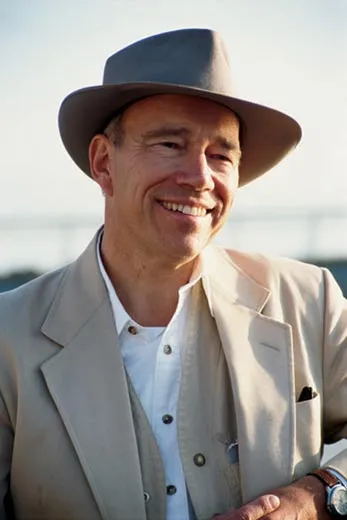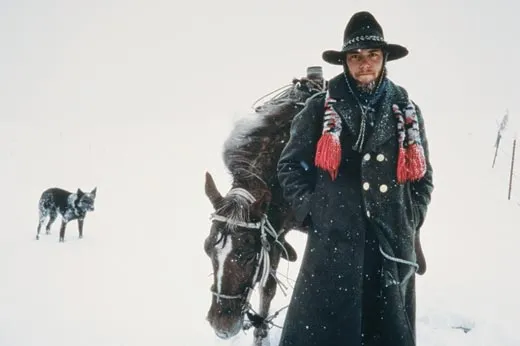The Cowboy in Winter
Gerald Mack lived the life—and photographer Sam Abell went along for the ride
/https://tf-cmsv2-smithsonianmag-media.s3.amazonaws.com/filer/indelible_abell_oct08_631.jpg)
Two black dots appeared in the distance, barely visible through swirling snow. Drawing closer, they resolved into recognizable forms: a man on a horse, a dog running alongside.
"That'll be Gerald," said Ken Perry, a rancher who had driven photographer Sam Abell high into the Little Belt Mountains of central Montana in 1985 to search for cowboys still working in the traditional style. "No one else would be up here" in the forbidding Montana winter.
In Abell's telling, he grabbed his camera, pushed open the door of Perry's pickup truck and stepped into the cold. There he began shooting pictures of a man named Gerald Mack, a horse named Sky and a dog named Cisco Kid.
The trio came to a stop in front of Abell. Introductions were made all around. Mack dismounted. Perry launched into a critique of Mack's horsemanship: You're riding him too hot. You ought to know better.
Mack hung his head. So did Cisco. The horse followed suit. Abell, a veteran of almost 40 National Geographic assignments, kept shooting. The elements of a picture were there, he sensed, but they had not fallen into place yet. He composed the frame, anticipating that Mack would eventually look up.
Sky snorted and shook off snow. Cisco looked up and pricked his ears. Mack raised his head. Abell squeezed off a picture. All three things happened at the same time, he says. "I was as set as a photographer can be. It was simply composing and waiting, which was how my father taught me to take pictures when I was a boy" in Sylvania, Ohio.
The resulting image of man, horse and dog was published in the January 1986 issue of National Geographic and is included among 200 pictures in The Life of a Photograph, a retrospective of Abell's field work to be published this month. It was one of 25,000 images Abell gathered during a year following in the footsteps of the late artist Charles M. Russell, who, as a teenager in the 1880s, had come to Montana from St. Louis to start life as a cowboy. To evoke Russell's time and spirit, Abell traveled to the windswept plains where Russell learned to ride and rope, where he honed his skills as a painter and where he memorialized the twilight of an era. "It looks the way it looked in Russell's day," says Abell, 63. "There are grander and more sublime landscapes—to me. There are more compelling cultures. But what appeals to me about central Montana is that the combination of landscape and lifestyle is the most compelling I've seen on this earth. Small mountain ranges and open prairie, and different weather, different light, all within a 360-degree view."
The cowboy culture was still very much in evidence when Mack rode into Abell's viewfinder more than two decades ago. Men and women spent their days in the saddle, following cattle up to the high grasslands in spring and summer and down to the valleys in fall, and drove off to town for a dance and a beer only when the chores were done. That life required good horse work, an affinity for the lariat and hard labor, a stoic acceptance of blistering summers and soul-numbing winters, and the quickness and strength to chase down a calf, flip it over and apply the branding iron. When spring arrived, so did the bloody work of transforming young bulls into steers, so a strong stomach helped, too.
Gerald Mack did all of those things in his season. He was the winter-keeper on Ken Perry's ranch when he met Abell, riding miles of fence lines to make sure there were no gaps, chopping holes in the ice so the cattle could drink. And dreaming of spring.
Cisco and Sky have since gone off to the big ranch beyond the mountains, but Mack remembers them fondly. "Cisco was always with me," he says. "He loved to help with the cattle or anything else that needed doing. He died a few years after the picture. Sky lived another nine or ten years. He was a good horse, a real good horse, tougher than a boot." Mack pauses. "He was a little bit counterfeit, though."
Counterfeit?
"Meaning he'd throw you in the dirt if you didn't keep one leg on each side and your mind in the middle," says Mack. "He'd take advantage."
At 47, Mack still lives in Charles Russell country, a few miles from where he first encountered Abell. But "cowboys are pretty scarce in this part of the country now," he says. "All the big ranches are in Nevada, Oregon, Northern California."
Has he hung up his spurs?
"I was cowboying until 1999, working here and there," Mack says, "I still do a little, but not much." He owns a saddlery near Hobson, Montana, where he makes bridles, chaps, quirts and hobbles for out-of-state cowboys. "Everything except for the saddles. I do a lot of braiding, working mostly with rawhide," he says. "Most of my business is through the Internet." His Web site is www.mackcustomleather.com.
Robert M. Poole is a writer and contributing editor at Smithsonian.

